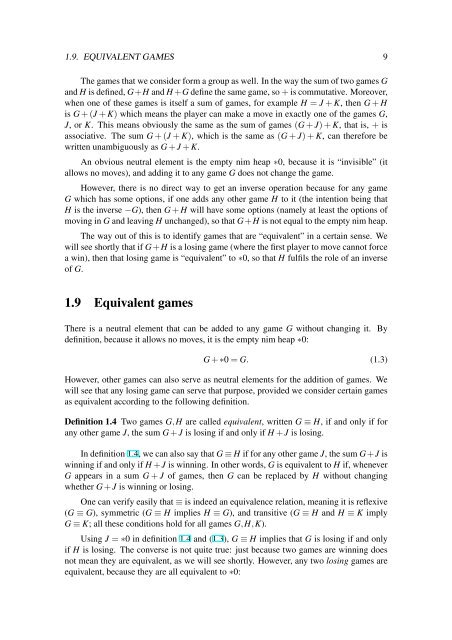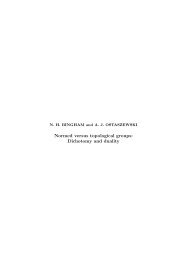Game Theory Basics - Department of Mathematics
Game Theory Basics - Department of Mathematics
Game Theory Basics - Department of Mathematics
Create successful ePaper yourself
Turn your PDF publications into a flip-book with our unique Google optimized e-Paper software.
1.9. EQUIVALENT GAMES 9The games that we consider form a group as well. In the way the sum <strong>of</strong> two games Gand H is defined, G+H and H +G define the same game, so + is commutative. Moreover,when one <strong>of</strong> these games is itself a sum <strong>of</strong> games, for example H = J + K, then G + His G + (J + K) which means the player can make a move in exactly one <strong>of</strong> the games G,J, or K. This means obviously the same as the sum <strong>of</strong> games (G + J) + K, that is, + isassociative. The sum G + (J + K), which is the same as (G + J) + K, can therefore bewritten unambiguously as G + J + K.An obvious neutral element is the empty nim heap ∗0, because it is “invisible” (itallows no moves), and adding it to any game G does not change the game.However, there is no direct way to get an inverse operation because for any gameG which has some options, if one adds any other game H to it (the intention being thatH is the inverse −G), then G + H will have some options (namely at least the options <strong>of</strong>moving in G and leaving H unchanged), so that G+H is not equal to the empty nim heap.The way out <strong>of</strong> this is to identify games that are “equivalent” in a certain sense. Wewill see shortly that if G+H is a losing game (where the first player to move cannot forcea win), then that losing game is “equivalent” to ∗0, so that H fulfils the role <strong>of</strong> an inverse<strong>of</strong> G.1.9 Equivalent gamesThere is a neutral element that can be added to any game G without changing it. Bydefinition, because it allows no moves, it is the empty nim heap ∗0:G + ∗0 = G. (1.3)However, other games can also serve as neutral elements for the addition <strong>of</strong> games. Wewill see that any losing game can serve that purpose, provided we consider certain gamesas equivalent according to the following definition.Definition 1.4 Two games G,H are called equivalent, written G ≡ H, if and only if forany other game J, the sum G + J is losing if and only if H + J is losing.In definition 1.4, we can also say that G ≡ H if for any other game J, the sum G+J iswinning if and only if H +J is winning. In other words, G is equivalent to H if, wheneverG appears in a sum G + J <strong>of</strong> games, then G can be replaced by H without changingwhether G + J is winning or losing.One can verify easily that ≡ is indeed an equivalence relation, meaning it is reflexive(G ≡ G), symmetric (G ≡ H implies H ≡ G), and transitive (G ≡ H and H ≡ K implyG ≡ K; all these conditions hold for all games G,H,K).Using J = ∗0 in definition 1.4 and (1.3), G ≡ H implies that G is losing if and onlyif H is losing. The converse is not quite true: just because two games are winning doesnot mean they are equivalent, as we will see shortly. However, any two losing games areequivalent, because they are all equivalent to ∗0:
















